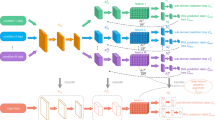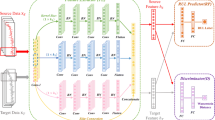Abstract
For aero-engine, due to the changeable working conditions and various failure modes, it is often difficult to estimate the remaining useful life (RUL) online. At the same time, it is difficult to calibrate the health status data of the engine. In this case, the traditional model-based prediction methods have poor adaptability. However, the data-driven methods have poor robustness due to the lack of a matching domain. We propose a transfer prediction method with an improved generative dversarial network (GAN). The sample data from different working conditions and different failure modes are transferred to the tested engine for life prediction, to solve the problem of training data sample acquisition. Firstly, a multi-source data fusion method for engine health indicators is proposed, which fuses multi-dimensional health features into one-dimensional health indicators. Then the sliding window method is employed to construct the time-series samples. Based on the idea of GAN, a dynamic adversarial domain adaptive transfer network is proposed to estimate the RUL of aero-engine. A weighted loss function is proposed and added to the network to improve the robustness. The experiment of C-MAPSS data is employed to test the proposed method at last.






Similar content being viewed by others
References
Li NP, Gebraeel N, Lei YG, Fang XL, Cai X, Yan T (2021) Remaining useful life prediction based on a multi-sensor data fusion model. Reliab Eng Syst Saf 208:11
Haque MS, Choi S (2021) Sparse kernel ridge regression assisted particle filter based remaining useful life estimation of cascode GaN FET. IEEE Trans Industr Electron 68(8):7516–7525
Wang G, Xiang JW (2021) Remain useful life prediction of rolling bearings based on exponential model optimized by gradient method. Measurement 176:9
Liao GB, Yin HP, Chen M, Lin Z (2021) Remaining useful life prediction for multi-phase deteriorating process based on Wiener process. Reliab Eng Syst Saf 207:11
Huang YX, Lu ZY, Dai W, Zhang WF, Wang B (2021) Remaining useful life prediction of cutting tools using an inverse Gaussian process model. Appl Sci-Basel 11(11):15
Liu H, Song WQ, Niu YH, Zio E (2021) A generalized cauchy method for remaining useful life prediction of wind turbine gearboxes. Mech Syst Signal Process 153:20
Pang ZN, Si XS, Hu CH, Du DB, Pei H (2021) A Bayesian inference for remaining useful life estimation by fusing accelerated degradation data and condition monitoring data. Reliab Eng Syst Saf 208:17
Jiao R, Peng K, Dong J (2021) Remaining useful life prediction for a roller in a hot strip mill based on deep recurrent neural networks. IEEE/CAA J Autom Sin 8(7):1345–1354
Wang X, Wang TY, Ming AB, Han QK, Chu FL, Zhang W, Li AH (2021) Deep spatiotemporal convolutional-neural-network-based remaining useful life estimation of bearings. Chin J Mech Eng 34(1):15
Fu S, Zhong S, Lin L, and Zhao M (2021). A novel time-series memory auto-encoder with sequentially updated reconstructions for remaining useful life prediction. IEEE Trans Neural Netw Learn Syst PP
Cai H, Feng J, Li W, Hsu YM, Lee J (2020) Similarity-based Particle Filter for Remaining Useful Life prediction with enhanced performance. Appl Soft Comput 94:106474
Cao Y, Jia M, Ding P, Ding Y (2021) Transfer learning for remaining useful life prediction of multi-conditions bearings based on bidirectional-GRU network. Measurement 178:109287
Tian QP, Wang HL (2021) Predicting remaining useful life of rolling bearings based on reliable degradation indicator and temporal convolution network with the quantile regression. Appl Sci-Basel 11(11):27
Gao Z, Hu QG, and Xu XY (2021) Condition monitoring and life prediction of the turning tool based on extreme learning machine and transfer learning. Neural Comput & Appl
Cheng H, Kong XG, Chen GG, Wang QB, Wang RB (2021) Transferable convolutional neural network based remaining useful life prediction of bearing under multiple failure behaviors. Measurement 168:13
Ragab M, Chen ZH, Wu M, Foo CS, Kwoh CK, Yan RQ, Li XL (2021) Contrastive adversarial domain adaptation for machine remaining useful life prediction. IEEE Trans Industr Inf 17(8):5239–5249
Ding N, Li HL, Yin ZW, Jiang FM (2021) A novel method for journal bearing degradation evaluation and remaining useful life prediction under different working conditions. Measurement 177:17
Mo Y, Wu Q, Li X, Huang B (2021) Remaining useful life estimation via transformer encoder enhanced by a gated convolutional unit. J Intell Manuf 32(7):1997–2006
Zeng FC, Li YM, Jiang YH, Song GQ (2021) An online transfer learning-based remaining useful life prediction method of ball bearings. Measurement 176:12
Huang GJ, Zhang YL, Ou JY (2021) Transfer remaining useful life estimation of bearing using depth-wise separable convolution recurrent network. Measurement 176:13
Zhang H, Zhang Q, Shao SY, Niu TL, Yang XY, Ding HB (2020) Sequential network with residual neural network for rotatory machine remaining useful life prediction using deep transfer learning. Shock Vib 2020:16
Berghout T, Benbouzid M, Mouss LH (2021) Leveraging label information in a knowledge-driven approach for rolling-element bearings remaining useful life prediction. Energies 14(8):18
Mao WT, He JL, Zuo MJ (2020) Predicting remaining useful life of rolling bearings based on deep feature representation and transfer learning. IEEE Trans Instrum Meas 69(4):1594–1608
Wang CS, Lu NY, Cheng YH, Jiang B (2021) A data-driven aero-engine degradation prognostic strategy. IEEE Trans Cybern 51(3):1531–1541
Peng J, Wang S, Gao D, Zhang X, Chen B, Cheng Y, Yang Y, Yu W, Huang Z (2020) A hybrid degradation modeling and prognostic method for the multi-modal system. Appl Sci 10(4):1378
Lim P, Goh CK, Tan KC (2018) A novel time series-histogram of features (TS-HoF) method for prognostic applications. IEEE Transac Emerg Top Comput Intell 2(3):204–213
Zhou HW, Huang JQ, Lu F (2017) Reduced kernel recursive least squares algorithm for aero-engine degradation prediction. Mech Syst Signal Process 95:446–467
Chen C, Zhu ZH, Shi JT, Lu NY, Jiang B (2021) Dynamic predictive maintenance scheduling using deep learning ensemble for system health prognostics. IEEE Sens J 21(23):26878–26891
Zhang XY, Xiao PC, Yang YZ, Cheng YJ, Chen B, Gao DZ, Liu WR, Huang ZW (2019) Remaining useful life estimation using CNN-XGB with extended time window. IEEE Access 7:154386–154397
Chen Z, Cao S, Mao Z (2017) Remaining useful life estimation of aircraft engines using a modified similarity and supporting vector machine (SVM) approach. Energies 11(1):28
Wang CS, Zhu ZH, Lu NY, Cheng YH, Jiang B (2021) A data-driven degradation prognostic strategy for aero-engine under various operational conditions. Neurocomputing 462:195–207
Bai JM, Zhao GS, Rong HJ (2020) Novel direct remaining useful life estimation of aero-engines with randomly assigned hidden nodes. Neural Comput Appl 32(18):14347–14358
Liu J, Lei F, Pan C, Hu D, Zuo H (2021) Prediction of remaining useful life of multi-stage aero-engine based on clustering and LSTM fusion. Reliab Eng & Syst Saf 214:107807
Park P, Jung M, Di Marco P (2020) Remaining useful life estimation of bearings using data-driven ridge regression. Appl Sci-Basel 10(24):17
Available: https://ti.arc.nasa.gov/tech/dash/groups/pcoe/prognostic-data-repository/ [Accessed].
Xia J, Feng Y, Lu C, Fei C, Xue X (2021) LSTM-based multi-layer self-attention method for remaining useful life estimation of mechanical systems. Eng Fail Anal 125:105385
Zhang XY, Lu X, Li WD, Wang S (2021) Prediction of the remaining useful life of cutting tool using the Hurst exponent and CNN-LSTM. Int J Adv Manuf Technol 112(7–8):2277–2299
Yao JC, Lu BC, Zhang JL (2022) Tool remaining useful life prediction using deep transfer reinforcement learning based on long short-term memory networks. Int J Adv Manuf Technol 118(3–4):1077–1086
Marei M, Li WD (2022) Cutting tool prognostics enabled by hybrid CNN-LSTM with transfer learning. Int J Adv Manuf Technol 118(3–4):817–836
Zhang A, Wang H, Li S, Cui Y, Liu Z, Yang G, Hu J (2018) Transfer learning with deep recurrent neural networks for remaining useful life estimation. Appl Sci 8(12):2416
Acknowledgements
This work was supported in part by the Suzhou Science and Technology Foundation of China under Grant SYG202021 and in part by Jiangsu Provincial Natural Science Research Foundation of China under Grant 20KJA460011 and 21KJA510003.
Author information
Authors and Affiliations
Corresponding author
Ethics declarations
Conflict of interest
The authors declared that they have no conflicts of interest in this work.
Additional information
Technical Editor: Samuel da Silva.
Publisher's Note
Springer Nature remains neutral with regard to jurisdictional claims in published maps and institutional affiliations.
Rights and permissions
About this article
Cite this article
Ge, Y., Zhang, F. Remaining useful life estimation for aero-engine with multiple working conditions via an improved generative adversarial network. J Braz. Soc. Mech. Sci. Eng. 44, 190 (2022). https://doi.org/10.1007/s40430-022-03493-z
Received:
Accepted:
Published:
DOI: https://doi.org/10.1007/s40430-022-03493-z




